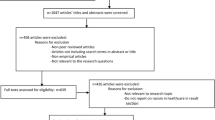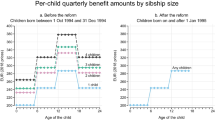Abstract
The success of black or white mothers in obtaining adequate prenatal care is examined. Two departures from public health convention are employed. The independent variables' marginal effects are calculated from their logit coefficients. The odds ratio of care adequacy between races is derived from race-specific regressions. It yields a smaller variance and type II decision error likelihood compared to the race dummy method.
A working-class life outlook and apathetic fathers are the highest barriers to adequate care. Wantedness, in the form of desired timing, is a very strong motivator. Improving upward socioeconomic mobility and paternal attitudes are important aspects of increasing prenatal care adequacy rates.
Similar content being viewed by others
References
Aved, Barbara; Mary Irwin; Lesley Cummings; Nancy Findeisen. 1993. “Barriers to Prenatal Care for Low-Income Women.” Western Journal of Medicine (158(5): 493–98.
Boggs, Kathleen; Jonnie McLeod; Thomas Stubbs. 1995. “Barriers to Prenatal Care in Mecklenburg County.” North Carolina Medical Journal 56(4): 159–63.
Braverman, Paula; Trude Bennett; Charlotte Lewis; Susan Egerter; Jonathan Showstack. (1993) “Access to Prenatal Care following Major Medicaid Eligibility Expansion.” Journal of the American Medical Association 269(10): 1285–89.
Coburn, Andrew and Thomas McDonald. 1992. “The Effects of Variations in AFDC and Medicaid Eligibility on Prenatal Care Use.” Social Science Medicine 35(8): 1055–63.
Cooney, Joan. 1985. “What Determines the Start of Prenatal Care?.” Medical Care 23(8):986–97.
Curry, Mary. 1989. “Nonfinancial Barriers to Prenatal Care.” Women and Health 15(3): 85–99.
Greene, William. 1993. Econometric Analysis, 2nd ed. New York: Macmillan.
Hellriegel, Don and John Slocum. 1979. Organizational Behavior, 2nd ed. St. Paul: West Publishing Company.
Institute of Medicine. 1988. Prenatal Care: Reaching Mothers, Reaching Infants. Joyce Lashoff, Chair Committee to Stud Outreach for Prenatal Care. Washington, D.C.: National Academy Press.
Johnson, Jannal; Phyllis Primas; Mary Coe. 1994. “Factors that prevent Women of Low Socioeconomic Status from Seeking Prenatal Care.” Journal of the American Academy of Nurse Practitioners, 6(3): 105–11.
Joyce, Kathleen; Geraldine Diffenbacher; Janet Greene; Yoram Rorokin. 1983. “Internal and External Barriers to Obtaining Prenatal Care.” Social Work in Health Care 9(2): 89–96.
Joyce, Theodore. 1994. “Self Selection, Prenatal Care, and Birthweight among Blacks, Whites, and Hispanics in New York City.” Journal of Human Resources, 29(3): 762–794.
Joyce, Theodore, and Michael Grossman. 1990. “Pregnancy Wantedness and the Early Initiation of Prenatal Care.” Demography, 27(1): 1–17.
Kessner, DM; J. Singer; C. Kalk; E. Schlesinger. 1973. Infant Dealth: An Analysis by Maternal Risk and Health Care. Washington DC: Institute of Medicine and National Academy of Sciences.
Kotelchuk, Milton. 1994a. “An Evaluation of the Adequacy of Prenatal Care and a Proposed Adequacy of Prenatal Care Utilization Index.” American Journal of Public Health, 84(9): 1414–20.
—. 1994b. “The Adequacy of Prenatal Care Utilization Index: Its US Distribution and Association with Low Birthweight.” American Journal of Public Health, 84(9): 1486–89.
LaViest, Thomas; Verna Keith; Mary Gutierrez. 1995. “Black/White Differences in Prenatal Care Utilization: An Assessment of Predisposing and Enabling Factors.” Health Services Research, 30(1), 43–58.
Lia-Hoagberg, Betty; Peter Roide; Catherine Skovholt; Charles Oberg; Cynthis Berg; Sara Mullett; Thomas Choi. 1990. “Barriers and Motivators to Prenatal Care among Low-Income Women.” Social Science Medicine, 30(4), 487–95.
McDonald, Thomas and Andrew Coburn. 1988. “Predictors of Prenatal Care Utilization.” Social Science Medicine, 27(2), 167–72.
Meikle, Susan; Miriam Orleans; Marilyn Leff; Rochelle Shain; Ronald Gibbs. 1995. “Women's Reasons for Not Seeking Prenatal Care: Racial and Ethnic Factors,” Birth, 22(2), 81–86.
Oberg, Charles; Betty Lia Hoagberg; Catherine Skovholt; Ellen Hodkinson; Renee Vanman. 1991. “Prenatal Care Use and Health Insurance Status.” Journal of Health Care for the Poor and Underserved, 2(2):270–92.
Perez-Woods, Rosanne. 1990, “Barriers to the Use of Prenatal Care: Critical Analysis of the Literature 1969–87.” Journal of Perinatology, 10(4), 420–34.
Poland, Marilyn; Joel Ager; Jane Olson. 1987. “Barriers to Receiving Adequate Prenatal Care.” American Journal of Obstetric Gynecology, 157(2), 297–303.
Rogers, Catherine and Melissa Schiff. 1996. “Early vs. Late Prenatal Care in New Mexico: Barriers and Motivators.” Brith, 23(1), 26–30.
Rosenzweig, Mark and Paul Schultz. 1991. “Who Receives Medical Care?.” Journal of Human Resources, 26(3), 473–508.
Sable, Marjorie; Joseph Stockbauer; Wayne Shramm; Garland Land. 1990. “Differentiating the Barriers to Adequate Prenatal Care in Missouri, 1987–88.” Public Health Reports, 105(6), 549–55.
U.S. Bureau of the Census. 1991. State and Metropolitan Area Data Book 1991. Dept. of Commerce, U.S. Government Printing Office.
U.S. Dept. of Health and Human Services National Center for Health Statistics. 1992. National Maternal and Infant Health Survey, 1988. Inter-University Consortium for Political and Social Research, Ann Arbor, MI.
About this article
Cite this article
Warner, G. Racial differences in the hurdling of prenatal care barriers. Rev Black Polit Econ 25, 95–114 (1997). https://doi.org/10.1007/s12114-997-1005-1
Issue Date:
DOI: https://doi.org/10.1007/s12114-997-1005-1




